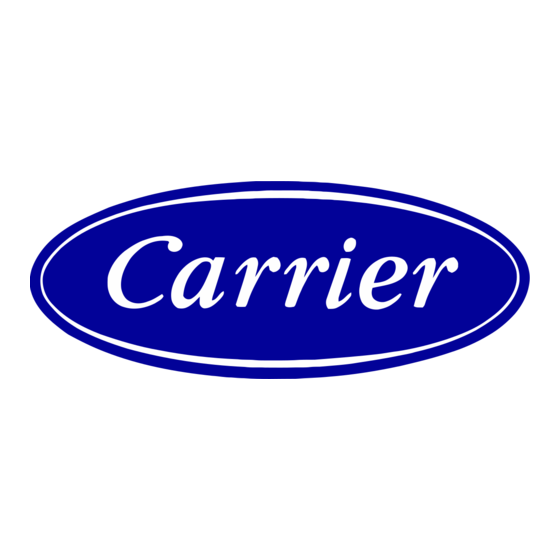Table of Contents
Advertisement
For the operation of the control please refer to
the Pro-Dialog
30RA/RH - 30RY/RYH "B" series
Control manual for the
30RY 017-080 "B"
Ductable Liquid Chillers with
Integrated Hydronic Module
Nominal cooling capacity 18-79 kW
50 Hz
AQUASNAP
Installation, operation and maintenance instructions
Carrier is participating in the
Eurovent Certification Programme.
Products are as listed in the
Eurovent Directory of Certified
Products.
Advertisement
Table of Contents

Summarization of Contents
Introduction to 30RY Chillers
Installation Safety Considerations
Guidelines and precautions for safe installation of the unit to prevent hazards.
Equipment and Components Under Pressure
Information on pressure-related components and safety considerations for their use.
Maintenance Safety Considerations
Safety rules and precautions for personnel performing maintenance on the unit.
Repair Safety Considerations
Safety guidelines for repairing the unit, including handling refrigerants and electrical hazards.
Electrical Connection
Power Supply
Requirements and guidelines for the unit's main power supply connection.
Voltage Phase Imbalance
Information on checking and maintaining voltage phase balance for unit operation.
Recommended Wire Sections
Field Control Wiring
Instructions for connecting the unit's control wiring to external systems.
Water Connections
Operating Precautions and Recommendations
Best practices and safety advice for water circuit connections and operation.
Hydronic Connections
Diagrams and details for connecting the hydronic system to the unit.
Frost Protection
Measures and procedures for protecting the unit from frost damage.
Installation of Accessory Condensate Recovery Pan
Instructions for installing an optional condensate recovery pan.
Nominal System Water Flow Control
Water Flow Control Procedure
Step-by-step guide to adjust the water flow using the control valve.
Pump Curve and Water Flow Control
Understanding pump curves and how pressure drops affect flow control.
Pump Pressure/Flow Rate Curves
Graphical representation of pump performance characteristics.
Available Static System Pressure
Data on the static pressure available from the pump for the system.
Duct Connection
Instructions for connecting air ducts to the unit for air-side applications.
Start-Up
Preliminary Checks
Essential checks to perform before attempting to start the chiller.
Actual Start-Up
Steps and important considerations for the actual startup process.
Operation of Two Units in Master/Slave Mode
Configuration and operation for dual-unit systems in master/slave setup.
Maintenance
General Maintenance of the Refrigerant Circuit
Routine cleaning and checks for the unit's refrigerant system.
Verification of the Refrigerant Charge
Procedures to check and verify the correct refrigerant charge in the system.
Apparent and Actual Subcooling
Understanding and measuring subcooling for refrigerant system performance.
Refrigerant Guidelines
General rules and best practices for handling refrigerants.
Recharging Liquid Refrigerant
Instructions for safely recharging the system with liquid refrigerant.
Undercharge
Identifying and addressing issues related to insufficient refrigerant charge.
Characteristics of R407C
Technical properties and data for the R407C refrigerant.
Electrical Maintenance
Procedures for maintaining the unit's electrical components.
Condenser Coil
Guidance on cleaning and maintaining the condenser coil for efficiency.
Aquasnap Maintenance Program
Maintenance Schedule
Recommended schedule for various maintenance services (A, B, C, D).
Description of Maintenance Operations
Detailed steps for performing maintenance tasks for Service A, B, C, and D.















Need help?
Do you have a question about the 30RY 060 and is the answer not in the manual?
Questions and answers